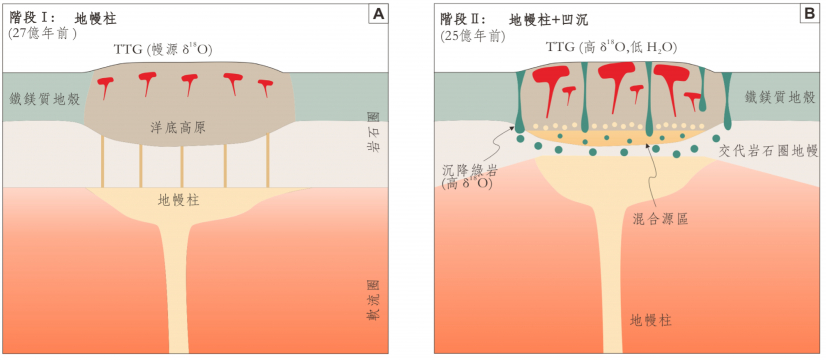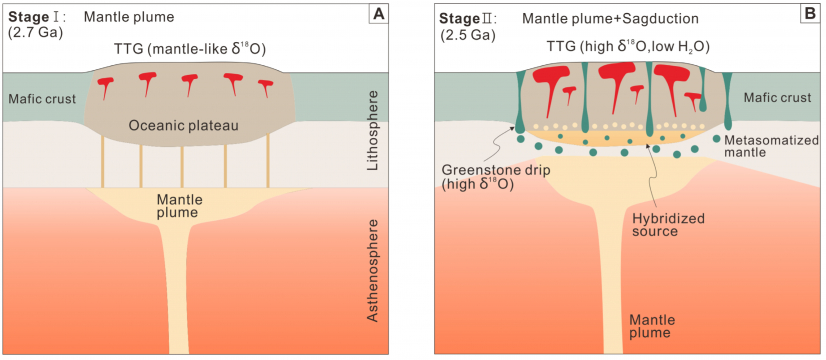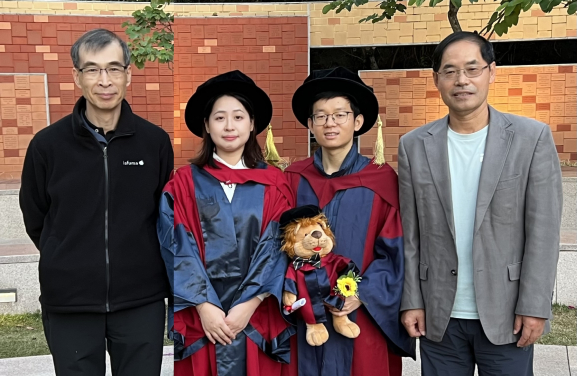Media
HKU Geologists Suggest Early Continents Formed through Mantle Plumes, Not Plate Collisions
03 Jul 2025

An illustration depicting the formation of TTGs in a two-stage mantle plume-sagduction model.
Image credit: Adapted from Zhao, D. et al. (2025). Science Advances. DOI: 10.1126/sciadv.adr9513.
Geologists from The University of Hong Kong (HKU) have made a breakthrough in understanding how the Earth’s early continents formed during the Archean time, more than 2.5 billion years ago. Their findings, recently published in Science Advances, suggest that early continental crust likely formed through deep Earth processes called mantle plumes, rather than the plate tectonics that shape continents today.
A New Perspective on Earth’s Early Crust
Unlike other planets in our solar system, Earth is a unique planet with continental crust—vast landmasses with granitoid compositions that support life. However, the origin of these continents has remained a mystery. Scientists have long debated whether early continental crust formed through plate tectonics, i.e., the subduction and collision of giant slabs of Earth’s crust, or through other processes that do not involve plate movement.
This study, led by Drs Dingyi ZHAO and Xiangsong WANG in Mok Sau-King Professor Guochun ZHAO’s Early Earth Research Group at the HKU Department of Earth and Planetary Sciences, together with international collaborators, has uncovered strong evidence that a distinct geodynamic mechanism shaped the Earth’s formative years. Rather than the plate tectonic processes we see today, the research points to a regime dominated by mantle plumes—towering columns of hot, molten rock ascending from deep within the Earth. It also identifies a phenomenon known as sagduction, wherein surface rocks gradually descend under their weight into the planet’s hotter, deeper layers. These findings shed new light on the dynamic processes that governed the early evolution of Earth’s lithosphere.
Studying Ancient Rocks to Understand the Deep Past
The team analysed ancient granitoid rocks called TTGs (tonalite–trondhjemite–granodiorite), which make up a large part of the oldest continental crust. These rocks, found in northern China, date back around 2.5 billion years. Using advanced techniques, the researchers studied tiny minerals within the rocks, known as zircons, which preserve chemical signatures from the time the rocks were formed.
By measuring the water content and oxygen isotope composition of these zircons, the team found that the rocks were formed in dry, high-temperature environments, unlike those typically found in zones where tectonic plates collide and one sinks below the other (subduction zones). The oxygen signatures also indicate a mixture of molten oceanic rocks and sediments, consistent with rocks formed above mantle plumes rather than subduction zones.
The researchers proposed a two-stage model to explain their findings:
- Around 2.7 billion years ago, a mantle plume caused thick piles of basalt (Fe- and Mg-rich volcanic rock) to form on the seafloor.
- Then, around 2.5 billion years ago, another mantle plume brought heat that caused the lower parts of these basalts to melt partially. This process produced the lighter TTG rocks that eventually formed continental crust.
Implications for Earth and Planetary Science
“Our results provide strong evidence that Archean continental crust did not have to be formed through subduction,” explained Dr Dingyi Zhao, postdoctoral fellow of the Department of Earth and Planetary Sciences and the first author of the paper. “Instead, a two-stage process involving mantle plume upwelling and gravitational sagduction of greenstones better explains the geochemical and geological features observed in the Eastern Block.”
The study distinguishes between two coeval Archean TTG suites—one plume-related and the other arc-related— by comparing their zircon water contents and oxygen isotopes. Professor Guochun Zhao emphasised “The TTGs from the Eastern Block contain markedly less water than those formed in a supra-subduction zone in the Trans-North China Orogen, reinforcing the interpretation of a non-subduction origin.”
“This work is a great contribution to the study of early Earth geodynamics,” co-author Professor Fang-Zhen Teng from the University of Washington added. “Our uses of zircon water and oxygen isotopes have provided a powerful new window into the formation and evolution of early continental crust.”
This study not only provides new insights into understanding the formation of Archean continental crust, but also highlights the application of water-based proxies in distinguishing between tectonic environments. It contributes to a growing body of evidence that mantle plumes played a major role in the formation of the early continental crust.
Journal paper: A two-stage mantle plume–sagduction origin of Archean continental crust revealed by water and oxygen isotopes of TTGs, by Dingyi Zhao et al., Science Advances (2025). DOI: 10.1126/sciadv.adr9513
For media enquiries, please contact HKU Faculty of Science (tel: 852-3917 4948/ 3917 5286; email: [email protected] / email: [email protected]).
Images download and captions: https://www.scifac.hku.hk/press
Supplementary Information
Researchers from HKU Department of Earth and Planetary Sciences
About Professor Guochun ZHAO
Professor Zhao is a highly esteemed geologist at HKU with international recognition, specialising in metamorphic petrology, Precambrian geology, and planetary geology. Having published 520 scientific papers and been cited over 75,000 times (H-index = 146), he has shaped the understanding of Earth’s early evolution and continental assembly. He was elected as a member of Chinese Academy of Sciences in 2019, a fellow of the World Academy of Sciences for the Advancement of Science in Developing Countries in 2021, a member of Hong Kong Academy of Sciences in 2023, and Mok Sau King Professor in HKU in 2025. In the 2025 Best Scientists Rankings by Research.com, Professor Zhao stands 6th in the world and 1st in China and Asia in Earth Sciences.
About Professor Min SUN
Professor Sun is a leading geochemist and petrologist at HKU. With over 350 peer‑reviewed publications and more than 60,000 citations, his research portfolio spans geochemical evolution, zircon geochronology, and continental tectonics. He serves as the Hong Kong Director of the Joint Chemical Geodynamics Laboratory with Chinese Academy of Sciences. In Research.com’s 2025 Best Scientists in Earth Science ranking, he stands at 20th globally and 4th in China.
About Dr Dingyi ZHAO
Dr Zhao is a petrological and geochemical researcher from HKU Department of Earth and Planetary Sciences, working with Professor Fang‑Zhen Teng in the Non‑Traditional Isotope Laboratory at the University of Washington. Her research focuses on the origin of Archean continental crust and Early Earth processes, combining innovative geochemical tools, field-based petrology, and international collaboration.
About Dr Xiangsong WANG
Dr Wang is a petrologist and planetary geologist at HKU Department of Earth and Planetary Sciences and Laboratory for Space Research. Collaborating internationally, he applies his expertise in deep-crustal and orogenic processes to planetary science, using remote sensing and planetary data to study Mercury and the Moon.


